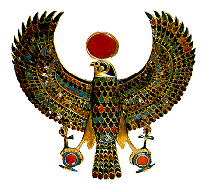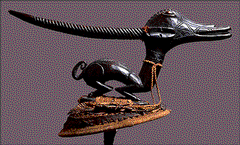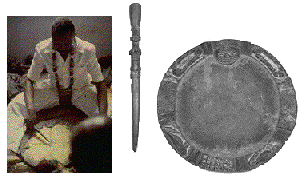|
|
|
Part I: African Secret
Societies |
|

|
The notion of the secret society is certainly nothing new in
the annals of history. In fact secret societies are among the oldest of
mankind's institutions. They exist on every continent and among many
different peoples. As we are speaking of Black fraternities and
sororities, this focus shall be upon the African secret society. African
secret societies were and still are common. They were an integral part
of society and permeated nearly every aspect of African life. These
societies were so important because they served several important
functions. |

|
The first purpose of the secret society was its
ritual of adulthood, or "rites of passage" as it is often called. Young
boys and girls were separated from family and society and placed with
their peers often in a gender orientated manner. In the guidance of
teachers, these youngsters would endure challenges of the mind by
learning and memorizing new information. They were also made to endure
challenges of the body. The purpose of this physical duress was to show
steadfastness and most importantly the philosophy of mind over matter.
These physical and mental tests helped to build bonds of trust between
not only the initiates but with their teachers as well. Once these rites
are completed, the initiates can enter society as adults. They can now
wear certain clothing and symbols. They can now adorn their bodies in
manners forbidden to them before (scarification, face painting, etc.) In
many societies it was common for the initiates to be taught secret
ceremonial dances as well as secret words, handshakes and signals
particular to whatever group they would now belong. In this manner young
boys and girls become men and women and thus functioning members of
society. Pictured above is a depiction of an African initiation
ceremony. |

|
The second purpose of the secret society was its
association with castes (not to be confused with the hierarchal social
castes of India). In many African societies one is born into a caste
that will mark one for life. Or one may become part of a caste when one
chooses one's career path in life. In many societies African professions
each had a caste. Blacksmith, iron smelter, farmer and warrior all
belonged to a certain caste as did most other professions. Many castes
functioned as apprenticeships. Once one became a member of the caste
through initiation, one could be taught the secrets of the craft be it
warfare or wood carving. An example of this can be seen among the Dogon
of Mali who even had a powerful funeral society for their "morticians."
An important feature of these castes was that though they were
different, they all worked together for the good of the society.
Pictured above is the head dress of the antelope-human Chiwara of the
Bambara: the mythical being who teaches farmers their secret
agricultural skills. |

|
The third purpose of the secret society was what can
be called the "sacred society." This function of the society was the
spiritual nature, already apparent in both the first and secondary
functions of the secret society, taken to its highest level. While both
the rites of passage and caste societies are spiritual in nature, it is
the sacred society which focuses on the upliftment of the soul. In this
sense one can see the deities often associated with the castes. Most
African masks were very spiritual in nature and could be worn only by a
duly initiated religious figure. And in order for anyone to become a
religious figure, the highest form of ritual and secret initiation was
performed. Pictured above is a Babaloawo, the diviner among the Yoruba
who holds a high and sacred place in society.
|
Written by Bro. Dexter Gabriel. Copyright Mu Nu
Chapter 2000. All rights reserved. Except as provided under U.S. copyright
law, all written information may not be reproduced, resold, distributed or
modified without the express permission the Mu Nu Chapter.
Pictures & Information Courtesy of
KAM
website & Africana Studies
Research Page
|
|
|
|
| |
Online
Poll
|
|
Online
Poll
Quote of the Week
Quiz Question
|
| Advertisements
|
|
|
|
|
|
|